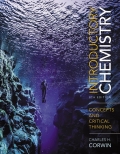
(a)
Interpretation:
The chemical formula for the ternary compound, potassium nitrate, given its constituent ions,
Concept introduction:
Compounds containing a metal and more than one other element are termed as ternary ionic compounds. The charge on the ternary ionic compounds must always be neutral.
Answer to Problem 17E
The chemical formula for the ternary compound, potassium nitrate is
Explanation of Solution
The ternary compound, potassium nitrate contains
The chemical formula for the ternary compound, potassium nitrate is
(b)
Interpretation:
The chemical formula for the ternary compound, ammonium dichromate, given its constituent ions,
Concept introduction:
Compounds containing a metal and more than one other element are termed as ternary ionic compounds. The charge on the ternary ionic compounds must always be neutral
Answer to Problem 17E
The chemical formula for the ternary compound, ammonium dichromate is
Explanation of Solution
The ternary compound, ammonium dichromate contains
The chemical formula for the ternary compound, ammonium dichromate is
(c)
Interpretation:
The chemical formula for the ternary compound, copper
Concept introduction:
Compounds containing a metal and more than one other element are termed as ternary ionic compounds. The charge on the ternary ionic compounds must always be neutral
Answer to Problem 17E
The chemical formula for the ternary compound, copper
Explanation of Solution
The ternary compound, copper
The chemical formula for the ternary compound, copper
(d)
Interpretation:
The chemical formula for the ternary compound, manganese
Concept introduction:
Compounds containing a metal and more than one other element are termed as ternary ionic compounds. The charge on the ternary ionic compounds must always be neutral
Answer to Problem 17E
The chemical formula for the ternary compound, manganese
Explanation of Solution
The ternary compound, manganese
The chemical formula for the ternary compound, manganese
Want to see more full solutions like this?
Chapter 6 Solutions
EBK INTRODUCTORY CHEMISTRY
- 3-58 In Section 2-3B, we saw that there are seven diatomic elements. (a) Draw Lewis structures for each of these diatomic elements. (b) Which diatomic elements are gases at room temperature? Which are liquids? Which are solids?arrow_forwardFrom the following written description, write the balanced chemical equation for the reaction including state symbols. A diatomic gaseous molecule that contains 17 protons per atom is reacted with a solid element that has an atomic number of 19 to yield an ionic compound.arrow_forwardClassify the following compounds as electrolytes or nonelectrolytes. (a) potassium chloride, KCL (b) hydrogen peroxide, H2O2 (c) methane, CH4 (d) barium nitrate, Ba(NO3)2arrow_forward
- 2-73 (Chemical Connections 2D) Copper is a soft metal. how can it be made harder?arrow_forwardArrange the following in the order of increasing mass. (a) a potassium ion, K+ (b) a phosphorus molecule, P4 (c) a potassium atom (d) a platinum atomarrow_forward2-59 You are presented with a Lewis dot structure of element X as X.. To which two groups in the Periodic Table might this element belong?arrow_forward
 Chemistry: Principles and ReactionsChemistryISBN:9781305079373Author:William L. Masterton, Cecile N. HurleyPublisher:Cengage Learning
Chemistry: Principles and ReactionsChemistryISBN:9781305079373Author:William L. Masterton, Cecile N. HurleyPublisher:Cengage Learning World of Chemistry, 3rd editionChemistryISBN:9781133109655Author:Steven S. Zumdahl, Susan L. Zumdahl, Donald J. DeCostePublisher:Brooks / Cole / Cengage Learning
World of Chemistry, 3rd editionChemistryISBN:9781133109655Author:Steven S. Zumdahl, Susan L. Zumdahl, Donald J. DeCostePublisher:Brooks / Cole / Cengage Learning Introductory Chemistry: A FoundationChemistryISBN:9781337399425Author:Steven S. Zumdahl, Donald J. DeCostePublisher:Cengage Learning
Introductory Chemistry: A FoundationChemistryISBN:9781337399425Author:Steven S. Zumdahl, Donald J. DeCostePublisher:Cengage Learning Introduction to General, Organic and BiochemistryChemistryISBN:9781285869759Author:Frederick A. Bettelheim, William H. Brown, Mary K. Campbell, Shawn O. Farrell, Omar TorresPublisher:Cengage Learning
Introduction to General, Organic and BiochemistryChemistryISBN:9781285869759Author:Frederick A. Bettelheim, William H. Brown, Mary K. Campbell, Shawn O. Farrell, Omar TorresPublisher:Cengage Learning Introductory Chemistry: An Active Learning Approa...ChemistryISBN:9781305079250Author:Mark S. Cracolice, Ed PetersPublisher:Cengage Learning
Introductory Chemistry: An Active Learning Approa...ChemistryISBN:9781305079250Author:Mark S. Cracolice, Ed PetersPublisher:Cengage Learning





